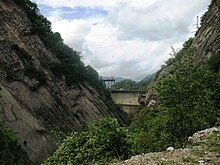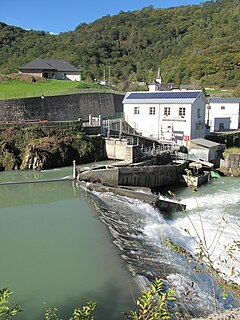
Small hydro is the development of hydroelectric power on a scale suitable for local community and industry, or to contribute to distributed generation in a regional electricity grid. Precise definitions vary, but a "small hydro" project is less than 50 megawatts (MW), and can be further subdivide by scale into "mini" (<1MW), "micro" (<100 kW), "pico" (<10 kW). In contrast many hydroelectric projects are of enormous size, such as the generating plant at the Three Gorges Dam at 22,500 megawatts or the vast multiple projects of the Tennessee Valley Authority.

Pumped-storage hydroelectricity (PSH), or pumped hydroelectric energy storage (PHES), is a type of hydroelectric energy storage used by electric power systems for load balancing. The method stores energy in the form of gravitational potential energy of water, pumped from a lower elevation reservoir to a higher elevation. Low-cost surplus off-peak electric power is typically used to run the pumps. During periods of high electrical demand, the stored water is released through turbines to produce electric power. Although the losses of the pumping process make the plant a net consumer of energy overall, the system increases revenue by selling more electricity during periods of peak demand, when electricity prices are highest. If the upper lake collects significant rainfall or is fed by a river then the plant may be a net energy producer in the manner of a traditional hydroelectric plant.

Hydroelectricity, or hydroelectric power, is electricity produced from hydropower. In 2015, hydropower generated 16.6% of the world's total electricity and 70% of all renewable electricity, and was expected to increase by about 3.1% each year for the next 25 years.

The Orlík Reservoir is the largest hydroelectric dam in the Czech Republic. It dams the Vltava River near the village of Solenice, which is near the town of Příbram. The structure is named after Orlík Castle, which is situated a few kilometers above the dam. The dam has four turbines with a nominal capacity of 91 MW each having a total capacity of 364 MW.

Bicaz-Stejaru Hydro Power Plant is a hydropower development on the Bistrița River, near Bicaz, Romania.
According to the International Hydropower Association, Canada is the world's fourth largest producer of hydroelectricity in the world in 2020 after the United States, Brazil, and China. In 2014, Canada consumed the equivalent of 85.7 megatonnes worth of oil of hydroelectricity, 9.8% of worldwide hydroelectric consumption. Furthermore, hydroelectricity accounted for 25.7% of Canada's total energy consumption. It is the third-most consumed energy in Canada behind oil and natural gas.
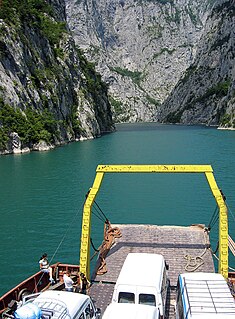
The Koman Hydroelectric Power Station is a large hydroelectric power station, for which a dam on the Drin River was built. The dam is near the settlement of Koman, northern Albania. It is the second of three dams on the Drin River; the Fierza Hydroelectric Power Station upstream, and the Vau i Dejës Hydroelectric Power Station downstream. The dam, 130m tall, was completed in 1985 and the reservoir was filled with water at full capacity in 1986.

The Mingachevir Dam is an earth-fill embankment dam on the Kura River just north of Mingachevir in Azerbaijan. It serves several purposes to include hydroelectric power production and water storage for irrigation. The Mingachevir reservoir, behind the dam, supplies water to the Upper Qarabag and Upper Sirvan Channels which help irrigate about 1,000,000 ha of farmland in the country. Its six Francis turbine-generators were overhauled or replaced with 70 megawatts (94,000 hp) sets in 2000. Mingachevir reservoir has a storage capacity of 15.730 cubic kilometres (12,753,000 acre⋅ft), covering 605 km2 (234 sq mi). The length of the dam is 1,550 metres (5,090 ft), its width is 16 metres (52 ft) and height is 80 m (260 ft). It is the largest hydroelectric power station in the South Caucasus, is located over Kur river and not far from Mingachevir city.
The Belmeken Hydro Power Plant is an active pumped storage hydro power project in the eastern Rila mountains, Bulgaria. It receives its water from the Belmeken Reservoir and has 5 individual turbines with a nominal output of around 75 megawatts (101,000 hp) which can deliver up to 375 megawatts (503,000 hp) of power, as well as 2 pumps with an installed capacity of 104 MW. It is part of the Belmeken-Chaira-Sestrimo Hydropower Cascade.
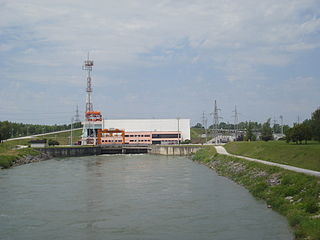
Dubrava Hydro Power Plant is a large power plant in Croatia that has four turbines with a nominal capacity of 21 MW each having a total capacity of 84 MW.
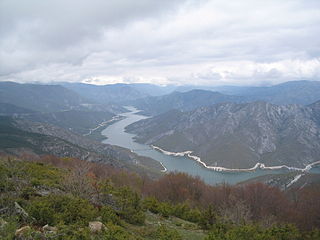
Kozjak Hydro Power Plant is a large hydroelectric power plant on the river Treska which creates an artificial lake Kozjak, the largest in North Macedonia. The dam which creates the reservoir, Kozjak Dam is the tallest in the country at 130 m (430 ft). It is located in the western part of the country in the municipality of Makedonski Brod. The primary purpose of the dam is flood control but it also serves for power generation.
Samtskhe–Javakheti Hydro Power Plant will be a large power plant in Georgia two has two turbines with a nominal capacity of 35 MW each having a total capacity of 70 MW.

Zhoneti Hydro Power Plant is proposed large power plant in village Zhoneti, Georgia with two turbines having a nominal capacity of 55 MW each for a total capacity of 110 MW.

Tvishi Hydro Power Plant will be a large power plant in Tsageri Municipality, Racha-Lechkhumi and Kvemo Svaneti, Georgia two has two turbines with a nominal capacity of 55 MW each having a total capacity of 110 MW.
![Namakhvani Hydro Power Plant Dam in Namakhyani [ka], Georgia](https://upload.wikimedia.org/wikipedia/commons/thumb/e/e7/Georgia_Imereti_relief_location_map.svg/320px-Georgia_Imereti_relief_location_map.svg.png)
Namakhvani Hydro Power Plant will be a large power plant to be built in the Tskaltubo and Tsageri municipalities north of Kutaisi, Imereti region, Georgia and will have five turbines with a nominal capacity of 50 MW each having a total capacity of 250 MW.

Vardnili Hydro Power Plant Cascade is a cascade of hydropower plants in the Gali Municipality of Georgia. Included in the Cascade of Enguri Hydropower Plants. It consists of four relatively smaller power plants. It is built on the outlet channel of the Enguri Hydro Power Plant, by discharging the main runoff of the Enguri River into the Eristskali riverbed. The total projected installed capacity is 340 MW, and the average annual projected electricity output is 1111 million kWh. The Vardnil HPP-I has 3 turbines with a nominal capacity of 73 MW each having a total capacity of 220 MW.
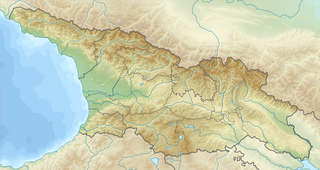
Khudoni Hydro Power Plant, hereinafter referred to as Khudoni HPP, is a projected power plant on Enguri River, in Samegrelo-Zemo Svaneti, Georgia that has 3 turbines with a nominal capacity of 233.3 MW each having a total capacity of 700 MW. The power plant is associated with a planned 200.5-metre (658 ft) tall concrete double-arch-gravity dam. According to the Georgian government-commissioned and the World Bank-supported study the construction of Namakhvani, Paravani and Khudoni hydro power plants are the most attractive scenarios for the development of Georgia's energy sector.

Khrami Hydro Power PlantI and II is a large power plant in Georgia that has 4 turbines with a nominal capacity of 55 MW each having a total capacity of 220 MW.

The Zhinvali Dam is a hydroelectric dam on the Aragvi River in the Caucasus Mountains in Zhinvali, Georgia. The Zhinvali Hydroelectric Power Plant has two turbines with a nominal capacity of 65 MW each having a total capacity of 130 MW.
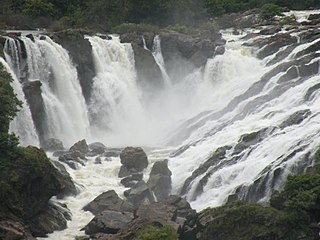
India is 5th globally for installed hydroelectric power capacity. As of 31 March 2020, India's installed utility-scale hydroelectric capacity was 46,000 MW, or 12.3% of its total utility power generation capacity. Additional smaller hydroelectric power units with a total capacity of 4,683 MW have been installed. India's hydroelectric power potential is estimated at 148,700 MW at 60% load factor. In the fiscal year 2019–20, the total hydroelectric power generated in India was 156 TWh with an average capacity factor of 38.71%.
